Aroma Identification and Classification in 18 Kinds of Teas (Camellia sinensis) by Sensory Evaluation, HS-SPME-GC-IMS/GC × GC-MS, and Chemometrics
Abstract
1. Introduction
2. Materials and Methods
2.1. Tea Sample Collection
2.2. Chemicals
2.3. Sensory Evaluation
2.4. HS-SPME
2.5. Gas Chromatography-Ion Mobility Spectrometer (GC-IMS)
2.6. Fast Switchable System between GC-O-MS and Two-Dimensional Comprehensive Gas Chromatography-Olfactometry-Mass Spectrometry Analysis (GC × GC-O-MS)
2.7. Statistical Analysis
3. Results and Discussion
3.1. Sensory Evaluation
3.2. Identification of Volatile Compounds by HS-GC-IMS Analysis
3.3. Identification of Aroma-Active Compounds in 18 Kinds of Teas by Two-Dimensional Comprehensive Gas Chromatography-Olfactometry-Mass Spectrometry Analysis (GC × GC-O-MS) Analysis
3.4. Correlation Analysis between Aroma-Active Compounds and Sensory Attributes
4. Conclusions
Supplementary Materials
Author Contributions
Funding
Data Availability Statement
Acknowledgments
Conflicts of Interest
References
- da Silva Pinto, M. Tea: A new perspective on health benefits. Food Res. Int. 2013, 53, 558–567. [Google Scholar] [CrossRef]
- Ho, C.T.; Zheng, X.; Li, S. Tea aroma formation. Food Sci. Hum. Well. 2015, 4, 9–27. [Google Scholar] [CrossRef]
- Baldermann, S.; Yang, Z.; Katsuno, T.; Tu, V.A.; Mase, N.; Nakamura, Y.; Watanabe, N. Discrimination of green, oolong, and black teas by GC-MS analysis of characteristic volatile flavor compounds. Am. J. Analyt. Chem. 2014, 5, 620–632. [Google Scholar] [CrossRef]
- Zhang, L.; Ho, C.T.; Zhou, J.; Santos, J.S.; Armstrong, L.; Granato, D. Chemistry and biological activities of processed Camellia sinensis teas: A comprehensive review. Compr. Rev. Food Sci. Food Saf. 2019, 18, 1474–1495. [Google Scholar] [CrossRef]
- Zhang, L.; Zeng, Z.; Zhao, C.; Kong, H.; Lu, X.; Xu, G. A comparative study of volatile components in green, oolong and black teas by using comprehensive two-dimensional gas chromatography-time-of-flight mass spectrometry and multivariate data analysis. J. Chromatogr. A 2013, 1313, 245–252. [Google Scholar] [CrossRef]
- Xu, J.; Zhang, Y.; Yan, F.; Tang, Y.; Yu, B.; Chen, B.; Lu, L.; Yuan, L.; Wu, Z.; Chen, H. Monitoring changes in the volatile compounds of tea made from summer tea leaves by GC-IMS and HS-SPME-GC-MS. Foods 2023, 12, 146. [Google Scholar] [CrossRef]
- GB14487-2017; Tea Vocabulary for Sensory Evaluation. Standardization Administration of China: Beijing, China, 2017.
- Wang, L.F.; Lee, J.Y.; Chung, J.O.; Baik, J.H.; So, S.; Park, S.K. Discrimination of teas with different degrees of fermentation by SPME–GC analysis of the characteristic volatile flavour compounds. Food Chem. 2008, 109, 196–206. [Google Scholar] [CrossRef] [PubMed]
- Sanderson, G.W.; Grahamm, H.N. Formation of black tea aroma. J. Agric. Food Chem. 1973, 21, 576–585. [Google Scholar] [CrossRef]
- Zheng, X.Q.; Li, Q.S.; Xiang, L.P.; Liang, Y.R. Recent advances in volatiles of teas. Molecules 2016, 21, 338. [Google Scholar] [CrossRef]
- Wang, M.; Zhu, Y.; Zhang, Y.; Shi, J.; Lin, Z.; Lv, H. A Review of Recent Research on Key Aroma Compoudns in Tea. Foood Sci. 2019, 40, 341–349. [Google Scholar]
- Zhang, Y.; Yin, J.; Liu, Z.; Xu, Y. Research progress of applicaiton of molecular sensory science technology in tea flavor. J. Food Saf. Qual. 2018, 9, 5922–5929. [Google Scholar]
- Feng, Z.; Li, Y.; Li, M.; Wang, Y.; Zhang, L.; Wan, X.; Yang, X. Tea aroma formation from six model manufacturing processes. Food Chem. 2019, 285, 347–354. [Google Scholar] [CrossRef]
- Zhou, Y.; Yu, J.; Wang, L.; Wu, D.; Qi, D.; Sha, Y.; Liu, B. Identification of Volatile Components in Tea Infusions by Headspace–Programmed Temperature Vaporization–Gas Chromatography–Mass Spectrometry (HS–PTV–GC–MS) with Chemometrics. Anal. Lett. 2020, 53, 1902–1918. [Google Scholar] [CrossRef]
- Buettner, A.; Schieberle, P. Evaluation of key aroma compounds in hand-squeezed grapefruit juice (Citrus paradisi Macfayden) by quantitation and flavor reconstitution experiments. J. Agric. Food Chem. 2001, 49, 1358–1363. [Google Scholar] [CrossRef] [PubMed]
- Song, H. Food Flavor Chemistry and Analysis; China Light Industry Press: Beijing, China, 2018. [Google Scholar]
- Matheis, K.; Granvogl, M. Characterization of Key Odorants Causing a Fusty/Musty Off-Flavor in Native Cold-Pressed Rapeseed Oil by Means of the Sensomics Approach. J. Agric. Food Chem. 2016, 64, 8168–8178. [Google Scholar] [CrossRef]
- Yang, P.; Yu, M.; Song, H.; Xu, Y.; Lin, Y.; Granvogl, M. Characterization of Key Aroma-Active Compounds in Rough and Moderate Fire Rougui Wuyi Rock Tea (Camellia sinensis) by Sensory-Directed Flavor Analysis and Elucidation of the Influences of Roasting on Aroma. J. Agric. Food Chem. 2022, 70, 267–278. [Google Scholar] [CrossRef] [PubMed]
- Wang, S.; Chen, H.; Sun, B. Recent progress in food flavor analysis using gas chromatography–ion mobility spectrometry (GC–IMS). Food Chem. 2020, 315, 126158. [Google Scholar] [CrossRef]
- Phillips, J.B.; Luu, D.; Pawliszyn, J.B.; Carle, G.C. Multiplex gas chromatography by thermal modulation of a fused silica capillary column. Anal. Chem. 1985, 57, 2779–2787. [Google Scholar] [CrossRef]
- GB23776-2018; Methodology for Sensory Evaluation of Tea. Standardization Administration of China: Beijing, China, 2018.
- Wang, Z.; Han, H.; Wang, J. The latest research progress and application prospect of solid phase microextraction in sample analysis. Guangzhou Chem. Ind. 2020, 48, 18–20. [Google Scholar]
- Li, W.; Li, J.; Qin, Z.; Wang, Y.; Zhao, P.; Gao, H. Insights into the composition and antibacterial activity of amomum tsao-ko essential oils from different regions based on GC-MS and GC-IMS. Foods 2022, 11, 1402. [Google Scholar] [CrossRef]
- Yang, P.; Song, H.; Lin, Y.; Guo, T.; Wang, L.; Granvogl, M.; Xu, Y. Differences of characteristic aroma compounds in Rougui tea leaves with different roasting temperatures analyzed by switchable GC-O-MS and GC x GC-O-MS and sensory evaluation. Food Funct. 2021, 4797–4807. [Google Scholar] [CrossRef]
- Chen, C.; Chen, H.; Zhang, Y.; Thomas, H.R.; Frank, M.H.; He, Y.; Xia, R. TBtools: An Integrative Toolkit Developed for Interactive Analyses of Big Biological Data. Mol. Plant 2020, 13, 1194–1202. [Google Scholar] [CrossRef]
- Zhang, L.; Cao, Q.-Q.; Granato, D.; Xu, Y.-Q.; Ho, C.-T. Association between chemistry and taste of tea: A review. Trends Food Sci. Technol. 2020, 101, 139–149. [Google Scholar] [CrossRef]
- Chen, X.; Chen, D.; Jiang, H.; Sun, H.; Zhang, C.; Zhao, H.; Li, X.; Yan, F.; Chen, C.; Xu, Z. Aroma characterization of Hanzhong black tea (Camellia sinensis) using solid phase extraction coupled with gas chromatography–mass spectrometry and olfactometry and sensory analysis. Food Chem. 2019, 274, 130–136. [Google Scholar] [CrossRef] [PubMed]
- Guan, S.; Ao, C.; Wang, Z.; Zhao, M.; Zhao, D.; Yu, J. Effect of different frying techniques on the quality of West Lake Longjing tea. Chin. Tea Process. 2020, 57, 40–42. [Google Scholar]
- Shen, Y. Process and key points of producing Biluocun in Suzhou Dongting Mountain. Chin. Tea Process. 2022, 170, 47–50. [Google Scholar]
- Rong, B.; Jiang, Q.; Lin, S.; Lin, Q.; Li, L.; Hui, N. Comparison of the Aroma Qualities of Tieguanyin and Baiyaqilan Teas Based on GC-MS-O and OAV. Modern Food Sci. Tech. 2022, 38, 351–363. [Google Scholar]
- Yao, S.S.; Guo, W.F.; Lu, Y.; Jiang, Y.X. Flavor Characteristics of Lapsang Souchong and Smoked Lapsang Souchong, a Special Chinese Black Tea with Pine Smoking Process. J. Agric. Food Chem. 2005, 53, 8688–8693. [Google Scholar] [CrossRef] [PubMed]
- Lu, Y.; Du, L.; Xiao, D. Analysis of volatile components of Lapsang Souchong black tea. Sci. Tech. Food Ind. 2015, 36, 57–60. [Google Scholar]
- Wang, G. Analysis on process and development of Huangshan Maofeng by mechanism. Agric. Tech. Equipm. 2023, 398, 97–99. [Google Scholar]
- Yang, P.; Wang, H.; Cao, Q.; Song, H.; Xu, Y.; Lin, Y. Aroma-active compounds related to Maillard reaction during roasting in Wuyi Rock tea. J. Food Compost. Anal. 2023, 115, 104954. [Google Scholar] [CrossRef]
- Magagna, F.; Cordero, C.; Cagliero, C.; Liberto, E.; Rubiolo, P.; Sgorbini, B.; Bicchi, C. Black tea volatiles fingerprinting by comprehensive two-dimensional gas chromatography—Mass spectrometry combined with high concentration capacity sample preparation techniques: Toward a fully automated sensomic assessment. Food Chem. 2017, 225, 276–287. [Google Scholar] [CrossRef]
- Yu, M.; Yang, P.; Song, H.; Guan, X. Research progress in comprehensive two-dimensional gas chromatography-mass spectrometry and its combination with olfactometry systems in the flavor analysis field. J. Food Compost. Anal. 2022, 114, 104790. [Google Scholar] [CrossRef]
- Song, H.; Liu, J. GC-O-MS technique and its applications in food flavor analysis. Food Res. Int. 2018, 114, 187–198. [Google Scholar] [CrossRef]
- Hara, Y.; Luo, S.J.; Wickremasinghe, R.L.; Yamanishi, T. IV. Processing of tea. Food Rev. Int. 1995, 11, 409–434. [Google Scholar]
- Hara, Y.; Luo, S.J.; Wickremasinghe, R.L.; Yamanishi, T. VIII. Flavor of tea. Food Rev. Int. 1995, 11, 477–525. [Google Scholar]
- Hara, Y.; Luo, S.J.; Wickremasinghe, R.L.; Yamanishi, T. V. Chemical composition of tea. Food Rev. Int. 1995, 11, 435–456. [Google Scholar]
- Wang, K.; Liu, F.; Liu, Z.; Huang, J.; Xu, Z.; Li, Y.; Chen, J.; Gong, Y.; Yang, X. Comparison of catechins and volatile compounds among different types of tea using high performance liquid chromatograph and gas chromatograph mass spectrometer. Int. J. Food Sci. Technol. 2011, 46, 1406–1412. [Google Scholar] [CrossRef]
- Zeng, L.; Zhou, Y.; Fu, X.; Liao, Y.; Yuan, Y.; Jia, Y.; Dong, F.; Yang, Z. Biosynthesis of Jasmine Lactone in Tea (Camellia sinensis) Leaves and Its Formation in Response to Multiple Stresses. J. Agric. Food Chem. 2018, 66, 3899–3909. [Google Scholar] [CrossRef] [PubMed]
- Pripdeevech, P.; Wongpornchai, S. Chapter 26—Odor and Flavor Volatiles of Different Types of Tea. In Tea in Health and Disease Prevention; Preedy, V.R., Ed.; Academic Press: Cambridge, MA, USA, 2013; pp. 307–322. [Google Scholar]
- Mizukami, Y.; Sawai, Y.; Yamaguchi, Y. Changes in the Concentrations of Acrylamide, Selected Odorants, and Catechins Caused by Roasting of Green Tea. J. Agric. Food Chem. 2008, 56, 2154–2159. [Google Scholar] [CrossRef] [PubMed]
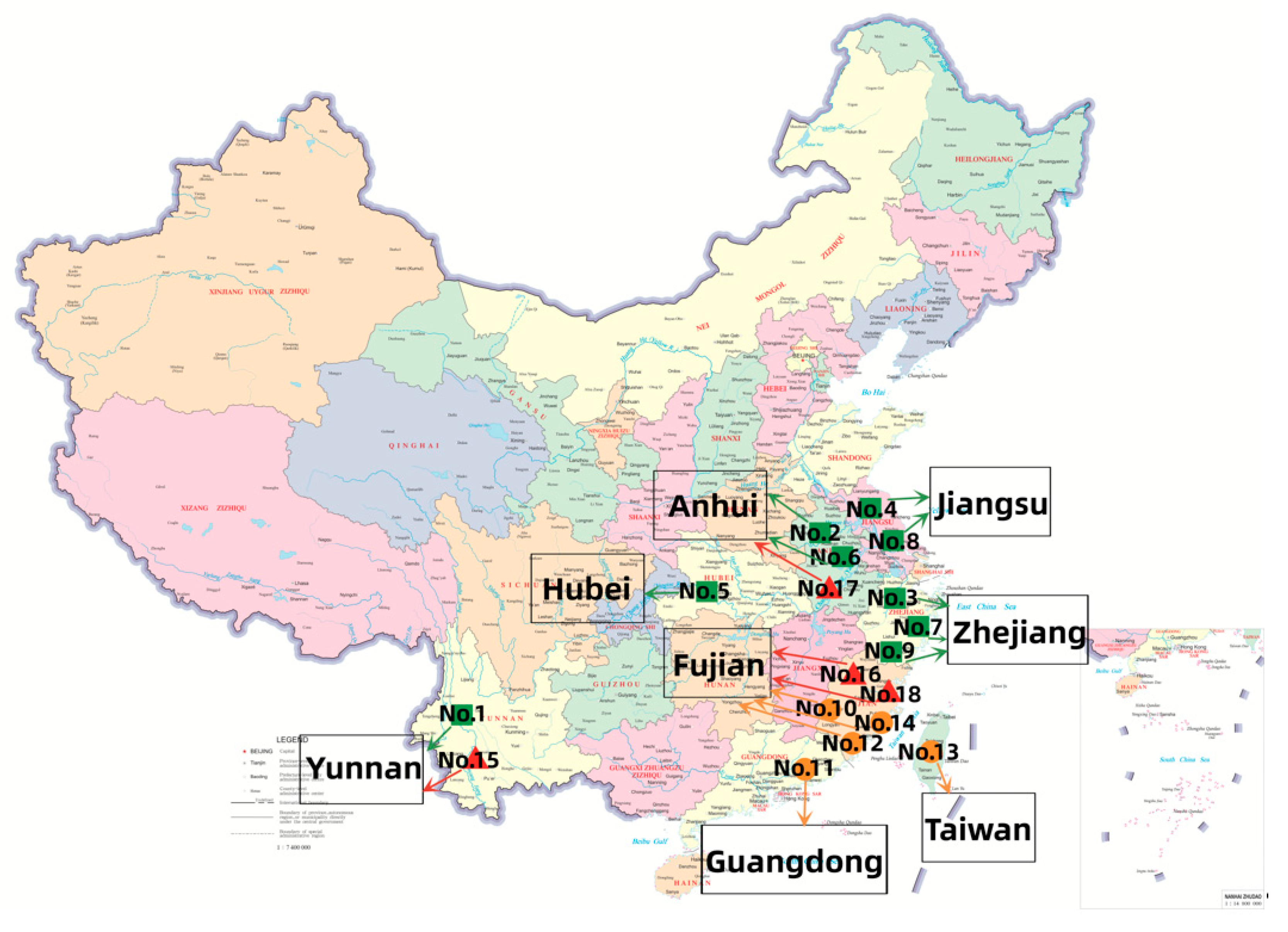
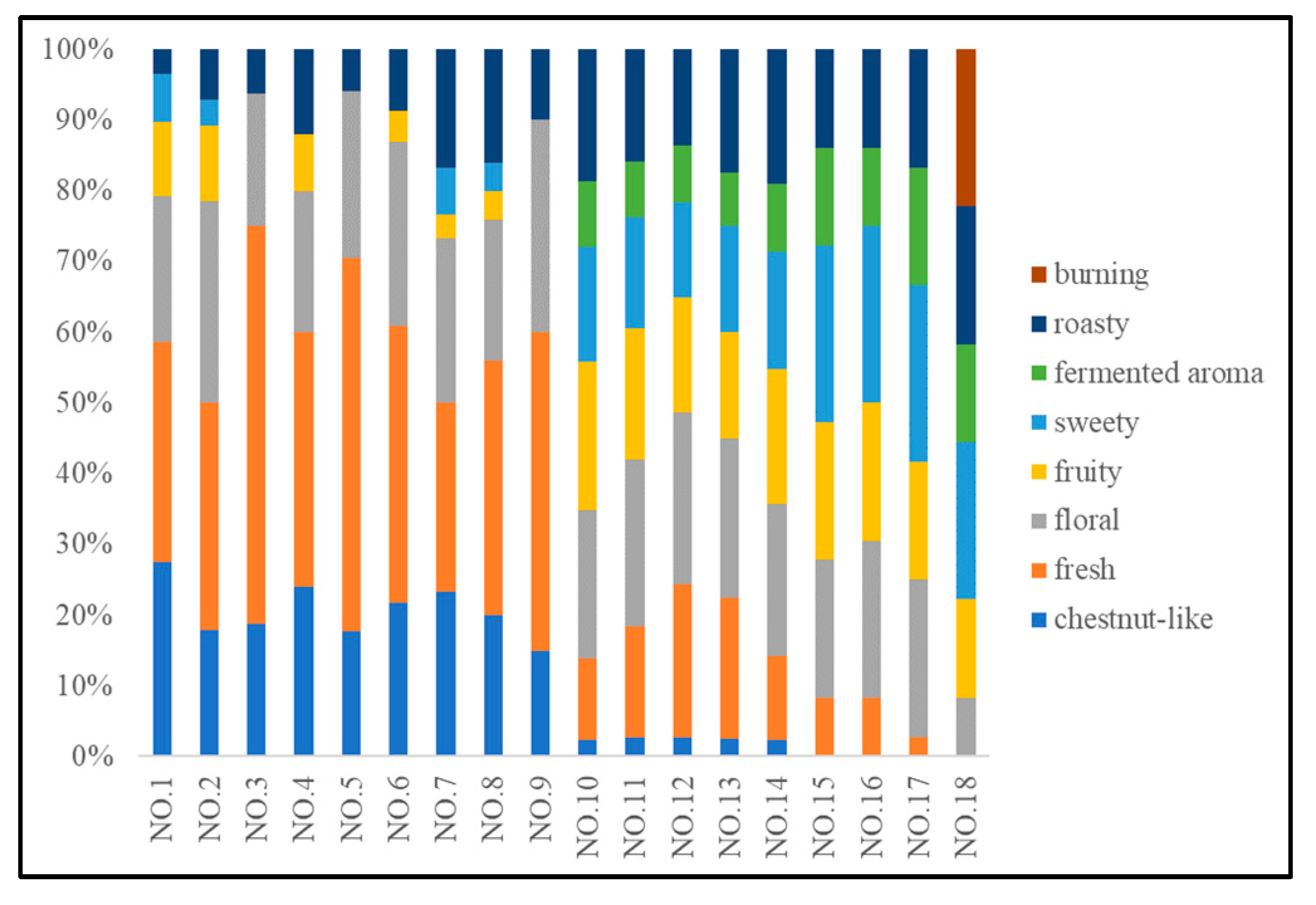
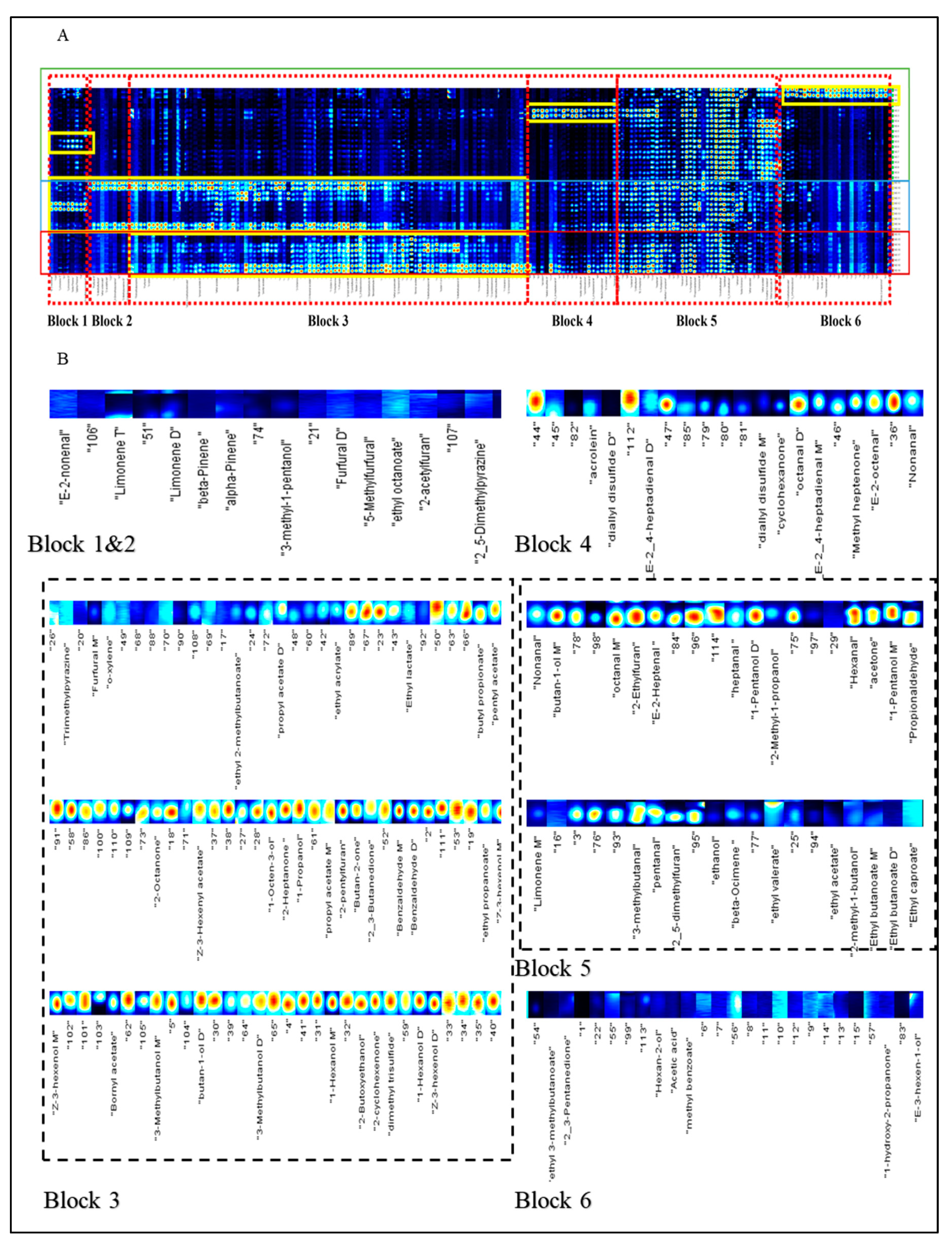



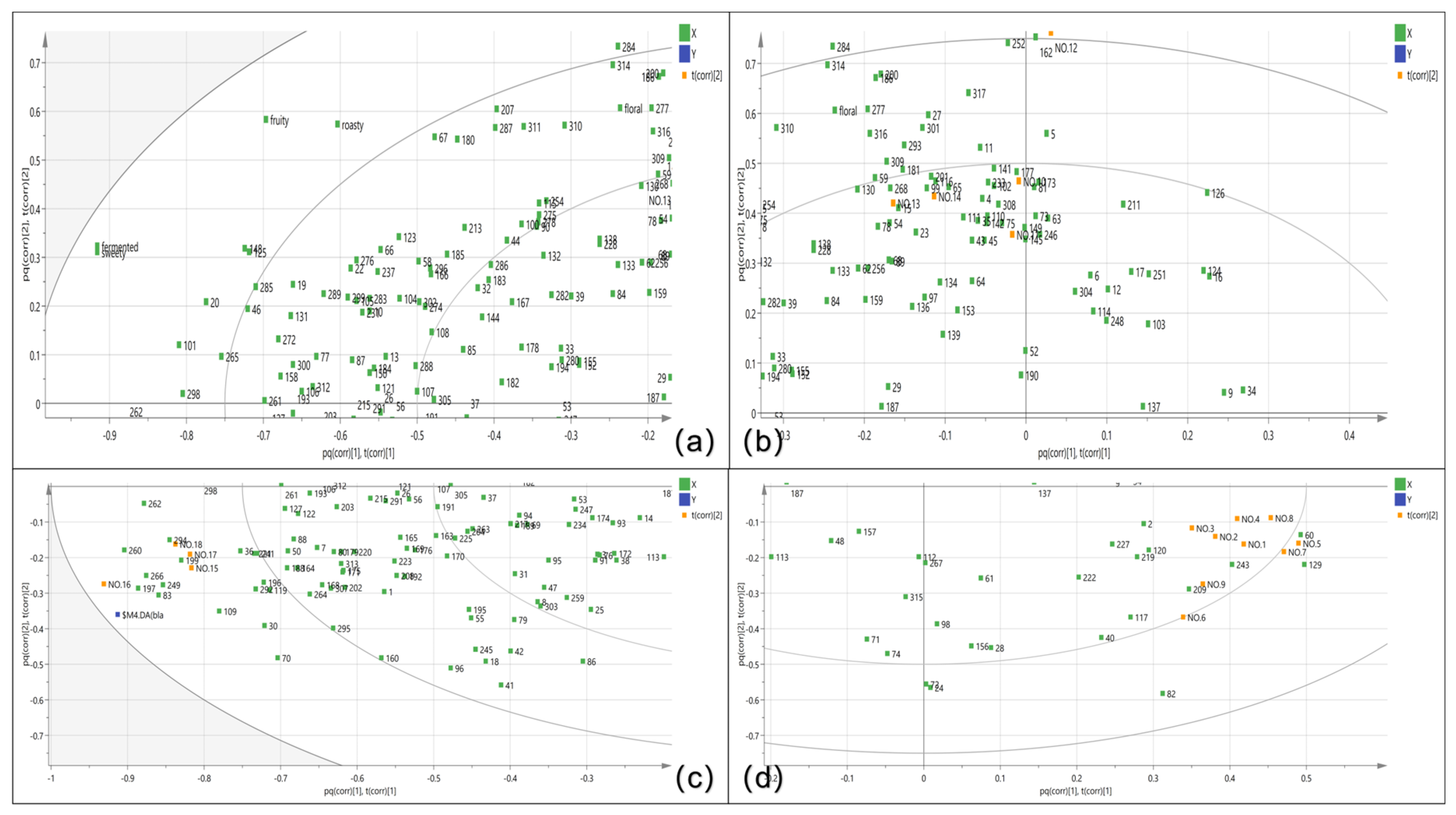
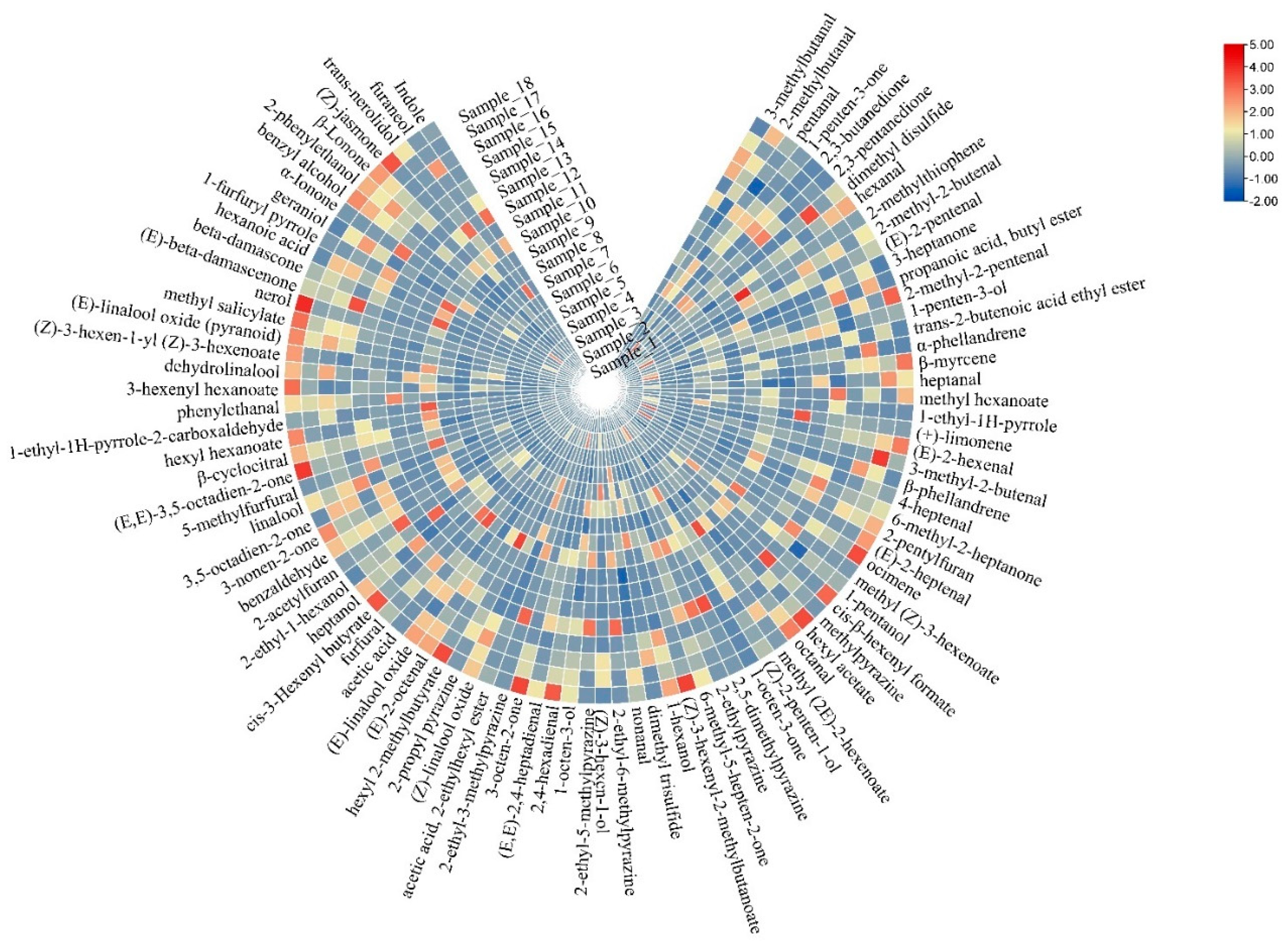
| No. | Tea Samples * | The Shape of a Dry Tea Leaf | Liquor Color | Aroma | Taste | Waste Leaves |
|---|---|---|---|---|---|---|
| Green Teas | ||||||
| 1 | Dian qing lu cha | Green, lenitive, uniform, and purity | Green, bright | Refreshing with a tender aroma | Mellow and brisk | Uniform and tender |
| 2 | Tai ping hou kui | Flat and heavy, uniform, with no visible pekoe, pale green, veins are dark red | Green, bright | Refreshing with flowery | The brisk and sweet aftertaste | Uniform, tender, and bright |
| 3 | Matcha | Tender, slender, uniform, and bright | Green, bright | Refreshing with flowery | Mellow | —— |
| 4 | Yu hua cha | Needle shape and tender with slight pekoe | Green, bright | Refreshing | The brisk and sweet aftertaste | Uniform, tender, and bright |
| 5 | En shi yu lu | Needle shape, dark green, and lenitive with slight pekoe | Green, bright | Refreshing | Mellow and brisk | Uniform, tender, and bright |
| 6 | Huang shan mao feng | Heavy, uniform, with pekoe, tender, green | Green, bright | Refreshing | The brisk and sweet aftertaste | Uniform, tender, and bright |
| 7 | Long jing cha | Flat with smooth, tight, heavy, tender, green, and lenitive | Green, bright | Refreshing and long-lasting | The mellow and brisk, sweet aftertaste | Uniform, tender, and bright |
| 8 | Bi luo chun | Slender, curly, and spiral, with pekoe, silvery green, lenitive, and uniform | Green, bright | Refreshing, with a tender aroma | The mellow and brisk, sweet aftertaste | Tender, uniform, and bright |
| 9 | An ji bai cha | Straight, uniform, green, and lenitive | Green, bright | Tender aroma, with long-lasting | The mellow and brisk, sweet aftertaste | White leaf with green vein, uniform |
| Oolong teas | ||||||
| 10 | Da hong pao | Fat, auburn, uniform, and purity | Bright orange-red | Flowery aroma with fruity notes | Mellow and thick, with obviously Yan flavor | Little soft with the toad’s back showing |
| 11 | Feng huang dan cong | Tight, auburn, and uniform | Bright orange-red | Flowery aroma | Mellow and thick, obviously Rock flavor | Soft and bright |
| 12 | Tie guan yin | Heavy, tender, lenitive, and uniform | Bright yellow-green | Flowery aroma | The mellow and thick, sweet aftertaste | Green leaf with red edge, soft |
| 13 | Dong ding wu long | Heavy, dark green, lenitive, and uniform | Green, bright | Flowery aroma | The mellow and thick, sweet aftertaste | Green leaf with red edge, soft |
| 14 | Shui xian | Heavy, dark brown, lenitive, uniform, and purity | Bright orange-red | Refreshing, with flowery notes | Mellow and thick, obviously Yan flavor | Green leaf with red edge, soft and bright |
| Black teas | ||||||
| 15 | Jin zhen dian hong | Needle shape and heavy, dark brown with lenitive, gold was revealed | Red, bright | Sweet and aromatic | Mellow and thick | Tender, red leaf, and bright |
| 16 | Jin jun mei | Curly, dark brown with gold revealed | Orange and yellow | Flowery aroma with fruity notes, long-lasting | Mellow and thick | Tender, red leaf, and bright |
| 17 | Qi men hong cha | Tender, gold was revealed, dark brown, lenitive | Red, bright | Tender, sweet and aromatic | The mellow and brisk, sweet aftertaste | Red leaf, soft, and tender |
| 18 | Zheng shan xiao zhong | Tight and lenitive | Orange and red, bright | Cinnamon aroma with caramel notes | Mellow and thick, with an obvious cinnamon flavor | Bronze leaf, tender, a little soft, and uniform |
Disclaimer/Publisher’s Note: The statements, opinions and data contained in all publications are solely those of the individual author(s) and contributor(s) and not of MDPI and/or the editor(s). MDPI and/or the editor(s) disclaim responsibility for any injury to people or property resulting from any ideas, methods, instructions or products referred to in the content. |
© 2023 by the authors. Licensee MDPI, Basel, Switzerland. This article is an open access article distributed under the terms and conditions of the Creative Commons Attribution (CC BY) license (https://creativecommons.org/licenses/by/4.0/).
Share and Cite
Lin, Y.; Wang, Y.; Huang, Y.; Song, H.; Yang, P. Aroma Identification and Classification in 18 Kinds of Teas (Camellia sinensis) by Sensory Evaluation, HS-SPME-GC-IMS/GC × GC-MS, and Chemometrics. Foods 2023, 12, 2433. https://doi.org/10.3390/foods12132433
Lin Y, Wang Y, Huang Y, Song H, Yang P. Aroma Identification and Classification in 18 Kinds of Teas (Camellia sinensis) by Sensory Evaluation, HS-SPME-GC-IMS/GC × GC-MS, and Chemometrics. Foods. 2023; 12(13):2433. https://doi.org/10.3390/foods12132433
Chicago/Turabian StyleLin, Yanping, Ying Wang, Yibiao Huang, Huanlu Song, and Ping Yang. 2023. "Aroma Identification and Classification in 18 Kinds of Teas (Camellia sinensis) by Sensory Evaluation, HS-SPME-GC-IMS/GC × GC-MS, and Chemometrics" Foods 12, no. 13: 2433. https://doi.org/10.3390/foods12132433
APA StyleLin, Y., Wang, Y., Huang, Y., Song, H., & Yang, P. (2023). Aroma Identification and Classification in 18 Kinds of Teas (Camellia sinensis) by Sensory Evaluation, HS-SPME-GC-IMS/GC × GC-MS, and Chemometrics. Foods, 12(13), 2433. https://doi.org/10.3390/foods12132433





